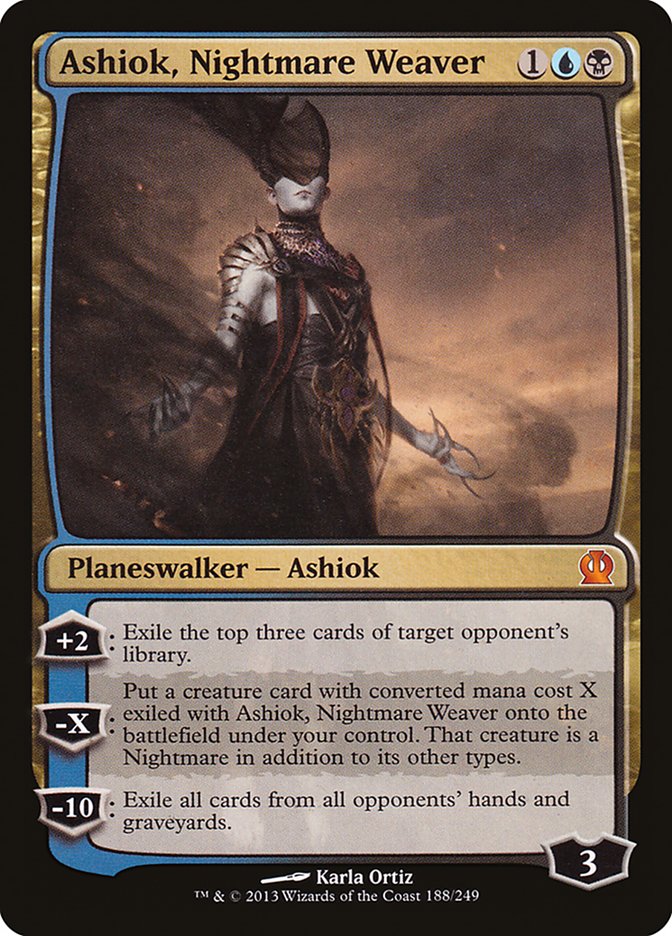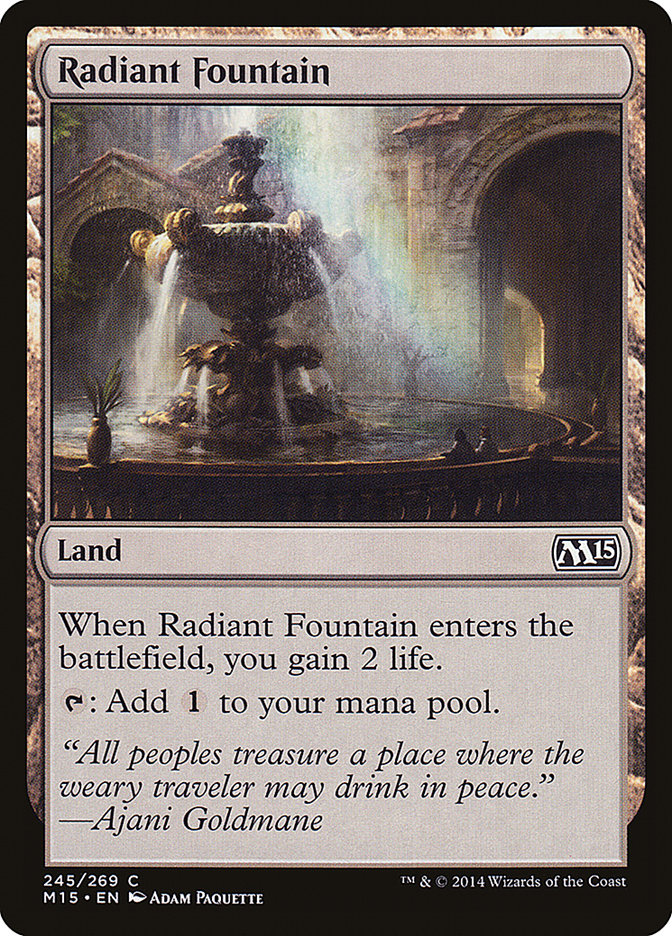“I didn’t make any mistakes.”
If you’ve gone to many Magic tournaments, you’ve likely heard this phrase spoken before. The more events you’ve gone to, the more you’ve probably heard it.
To me, this is very much the phrase of a novice player, even if that novice is very experienced. We make mistakes constantly. At the highest levels of the
game, Magic Hall of Fame player and current Wizards employee Mike Turian once said that every moment is a chance to make a mistake. He thought the wrong
body posture, the wrong word, the wrong look could be considered a mistake.
That, of course, is a pretty high bar.
If we want to limit the question of our mistakes to solely the ones that are within the realm of the cards, rather than the realm of physical cues and
mental game, we are still engaged in a game with an incredible variety of choices. Making mistakes is easy. What’s more, we can make plays that
are mistakes and not only win despite those mistakes, but win because of them.
Imagine, for example, that you’re playing Red Aggro against an Esper Dragons deck. They’ve killed some initial creatures, and you rode a Lightning
Berserker for a little while, while they used up a pair of Foul-Tongue Invocation, cast Dig Through Time, and untapped, saying go.
You’re a bit flooded, but your hand is Monastery Swiftspear, Dragon Fodder, Dragon Fodder. They are at four life. You cast it all: Monastery Swiftspear,
Dragon Fodder, Dragon Fodder, and attack. They go to one. They’re dead on the next turn. On their turn, they lay a Dragonlord Ojutai and have mana for a
fourth Foul-Tongue Invocation to go to five, but your topdecked Wild Slash means that they die, basically no matter what.
The better play is the play that is the most likely to result in a victory. Merely casting the Swiftspear into the first Dragon Fodder would have killed
the opponent just as quickly, but it also meant that you didn’t walk headlong into a sideboarded copy of Drown in Sorrow or a Bile Blight. You got rid of
all of your gas for the most effect now even when you weren’t even getting one less turn on the kill. They hadn’t yet played any Drowns or
Blights, so the odds were not in your favor.
The fact that this not only worked out, but ended up resulting in a victory does not make it the correct play. The correct play is the one that is
most likely to result in a way, not the one that happens to result in a win.
There is a very easy way to illustrate this.
Playing on Magic Online, you accidentally forget to activate your Ashiok, and as a result, your opponent draws three lands in a row that they didn’t need.
You end up barely winning the game because they lack sufficient spells.
Clearly, that’s just how it turned out and the right play was to activate the Ashiok. Don’t fall prey to The Ashiok Fallacy (formerly called The Millstone
Fallacy).
As you improve your own play, one of the most important things that you can do is not pay attention to whether you won or lost a game to determine whether
or not what happened was a mistake, but how close you played to what you perceive (as best you can) to be optimally.
The question of “What is Good Magic?” is something
you can understand if you don’t fool yourself into the mistaken belief that winning is “good” or that mistakes are rare, rather than the default.
At Grand Prix Toronto this weekend, my Team Ultra PRO teammate Paul Rietzl was recounting his day to some of us when he said, “God, I’m terrible. I’ve made
so many mistakes. Sometimes I wish I was still really bad, so I wouldn’t even notice all the times it happens.”
For my part, I also made countless little errors. However, aside from the little errors that we all make (and that we should all try to minimize, even if
we all make them), I made several colossal errors. Making errors is one thing. Looking to identify them and figuring out what happened is important.
Here were some of mine from this last Grand Prix.
The Radiant Fountain Situation
This one is pretty simple.
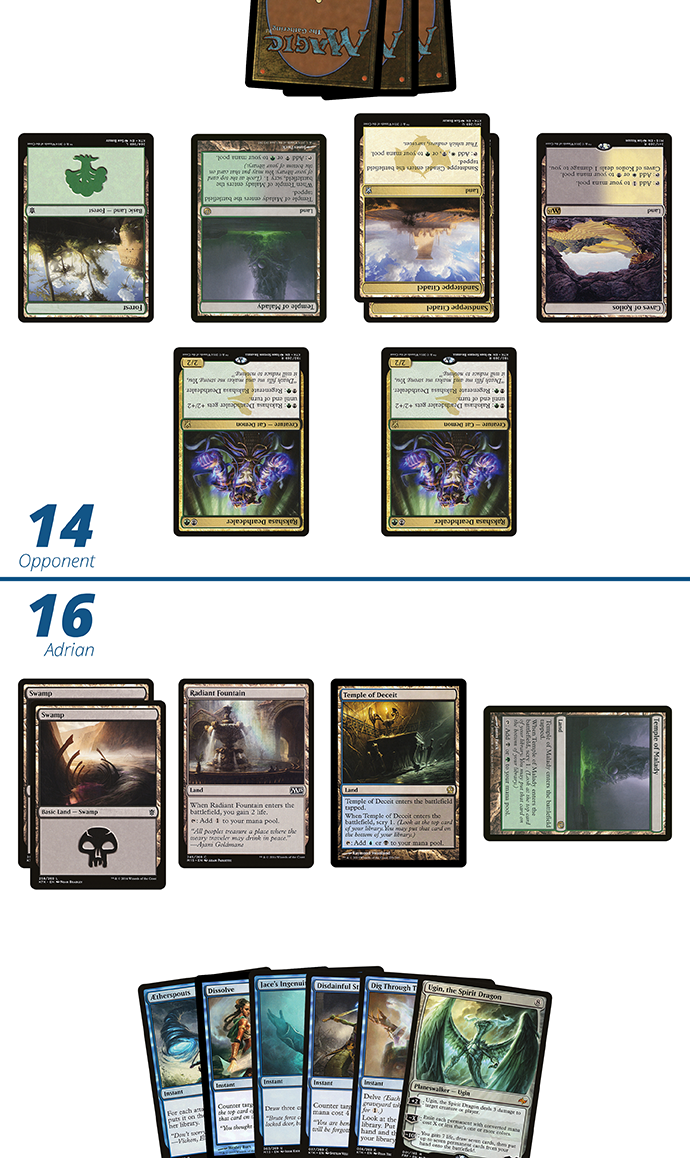
I’m playing against Abzan Aggro in game 2, and it has come out of the gates fast with a pair of Thoughtseize working me as the creatures come in. I kill a
few along the way, I drop my fifth land, Temple of Malady, and I scry.
I’m not exactly sure why I kept this card. I think, maybe, my brain went from thinking “I need a blue land” to “I need a land.”
My earlier scry, Temple of Deceit, had found the second Swamp when I was a little land light, and so maybe my brain continued to think to itself, “find
land.” Maybe I was swayed by the extra two life.
Whatever the case may be, here is the problem: Finding a non-blue land doesn’t do anything.
Finding a blue source is going to mean the world is my oyster. I have a lot of time to work with here, and even though I’ve already used some removal this
game, with such a full hand of cards, my opponent can’t readily pump up his Rakshasa Deathdealer without running the risk that it will result in the death
of one or both of them. What if, for example, he pumps a creature, I respond by Hero’s Downfall, he regenerates, mostly tapping out, and then I cast Crux
of Fate. Crux of Fate is the default removal sweeper for most of these decks, and it is hard to answer when you’re tapped out.
If I don’t draw a blue source, I still might be able to buy more time to find blue if I draw a removal spell, even if it is ineffectual. For that matter,
though, if I draw Silence the Believers, I can actually get some bang for my buck!
Radiant Fountain might build me towards Ugin, the Spirit Dragon, but that is the only way it interacts with this hand in this situation favorably, and even
then, for that to be successful, I still need to find two more land.
Keeping the Radiant Fountain was a really, really bad move.
Now, one needs to beware of looking at the specific situation and the result from it in the same way one needs to understand The Ashiok Fallacy: Just
because things would have worked out differently, it is not evidence that you should have done them. However, improving one’s chance for the good
result matters.
As it happens, the Radiant Fountain was followed by a Silence the Believers and then a Dismal Backwater. Drawing a Silence a turn earlier would have been
huge, and the Backwater came a turn too late to as powerfully impact the game as needed. I almost recovered but was a turn too slow.
The Bant Situation
Now we get to a situation that is a little more complicated.
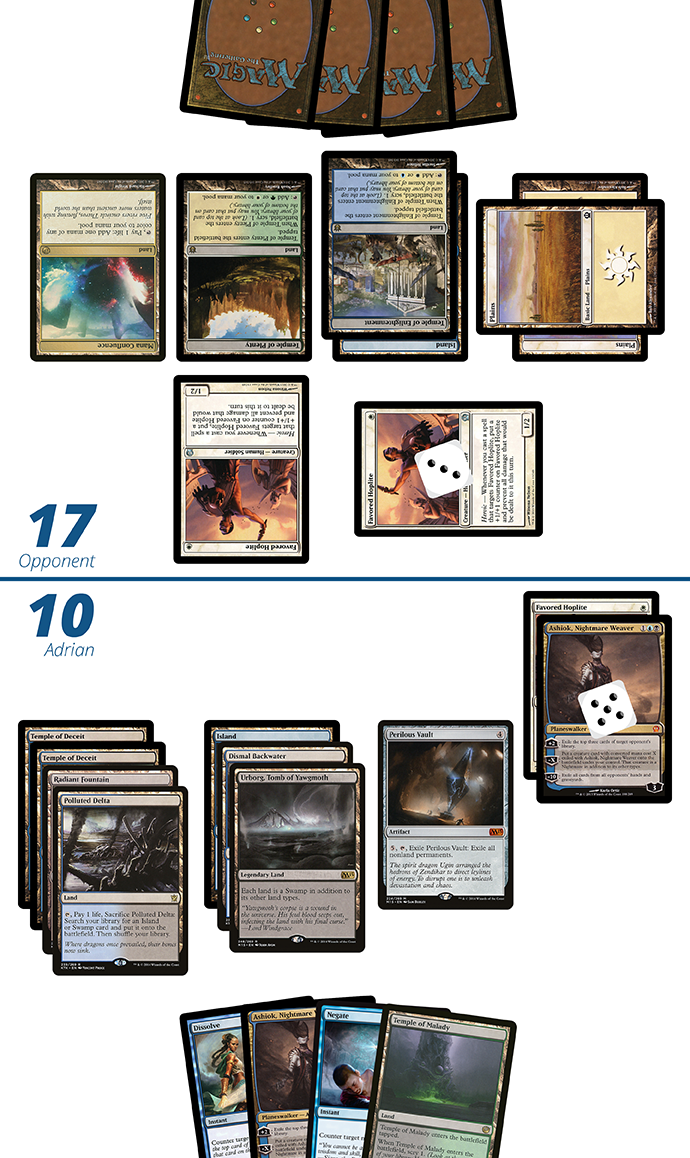
It’s my turn, and I’m facing a pretty solid clock, but I have some potential defenses up in Ashiok and Perilous Vault. It is a sideboarded game, so I know
I can expect some countermagic, and in fact, I’ve already seen some. It’s my main phase, and I’ve already laid a land, Radiant Fountain, so I can’t
potentially activate Vault and have Negate available to stop Treasure Cruise. I can’t wait around forever. Roughly, here are the options:
A) Activate Ashiok to put the Favored Hoplite into play and activate Perilous Vault in response, which will clear the table and leave me with a Favored
Hoplite versus nothing.
B) Activate Ashiok to put Favored Hoplite into play and defer other decisions until the next turn.
C) Activate Ashiok to remove the top three of my opponent’s library.
After a lot of thought, I chose option (A). This was wrong.
What this does is that it taps me down so that I can’t cast a Dissolve on the next turn, which means that my opponent can just redeploy new threats if he
has them. This was, in fact, what he did, dropping a third Favored Hoplite and a Monastery Mentor. It took several turns, but I did get overwhelmed.
Now, the issue is, I know that Heroic’s ability to win rests on its ability to deploy creatures. The Bant build of the deck has no reach and has
the unfortunate problem of sometimes either failing to have creatures or other times failing to have a way to make them meaningful. This is one of the
significant pairs of weaknesses for the deck.
No matter what I do, I can’t do option (A), because it removes my potential to strand my opponent with a weak boardstate.
The real question is whether to put a Favored Hoplite into play now, as a sacrifice to the altar of My Life Total, or whether to hunt for
something better. Since the land I have enters the battlefield tapped, I think that the best bet is to put it into play now and guarantee that I save four
precious life points, an amount that might actually make me live another turn longer if things are under duress later in the game.
So, option (B) is the thing I should do now. I’ll drop to nine, perhaps less if my opponent decides to invest anything into the unpumped Hoplite. If they
decide to invest a lot (say, casting Center Soul on the large Hoplite and going in for a potential kill with other cards) and force me to activate
my Perilous Vault, I can still do that. No matter what happens, though, my plan will be to activate the Perilous Vault, at the very latest at the end of my
opponent’s turn, and thus untap “in position” – that is, with nothing threatening on the board and all of my land untapped. If I draw an untapped land,
I’ll cast a new Ashiok, Nightmare Weaver, but if I don’t, I’ll just sit back for a turn and lay my Temple of Malady. What I want is the hard counter and
the backup soft counter to be able to minimize Bant Heroic’s chance to build a board presence and maximize my exploitation of the deck’s fundamental
weaknesses.
In the real world, I did survive for a few turns after my mistake, but the way the game played out, I would have been staring down a single, wimpy creature
while my Ashiok, Nightmare Weaver would have gone to work. It’s not guaranteed that I would have won, but the odds were very, very highly in my favor, and
it would have forced a game 3.
The Tasigur Situation
Let’s amp up the complicated nature of how games can go.
I’ve been doing my best to stay alive, but discard has been wrecking me. Tasigur nearly emptied out my graveyard, and my opponent has been attacking into
me, just regenerating their Deathdealer, occasionally pumping it to kill a creature of theirs I’ve stolen, lest something happen with my untapped mana. A
few Tasigur activations have gotten me an Ugin, the Spirit Dragon and the Disdainful Stroke I’ve already used, now in my graveyard, which includes the
spells you see below:
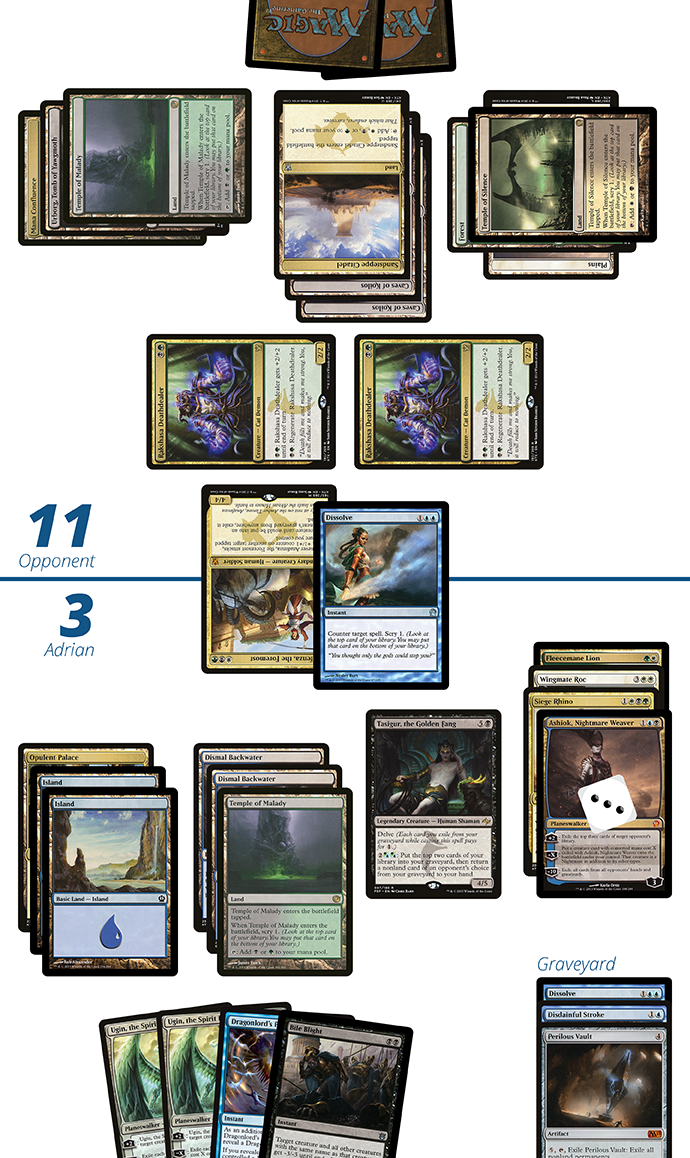
After an attack, I block, they regenerate their Deathdealer, and they cast an Anafenza, the Foremost. With my Bile Blight in hand, I actually can’t kill
anything, so, the question is whether or not to Dissolve the Anafenza. Obviously, if they have a Siege Rhino in hand, I am dead. Since they didn’t pump
again, this feels to me like perhaps they have a Siege Rhino.
If I let the Anafenza resolve, though, they don’t even have to cast the Rhino right then. They can wait until later for another opportunity to make use of
it, and unless I get lucky, I don’t think I can beat the Anafenza. It is possible that I could, at end of turn, Dragonlord’s Prerogative and find an answer
for the whole board, but my opponent has even seen Aetherspouts this match, so that isn’t a guaranteed blowout. And if I do let the Anafenza resolve, if
they follow up with Siege Rhino for the kill, then I certainly can’t cast Dragonlord’s Prerogative.
I just realize, “I have to hope they have nothing else of note.” It seems clear that I have to cast the Dissolve and hope.
I look at the top card of my library:
Here’s where the mistake comes in. I think about my graveyard, which will have four cards in it, and I think, “Well, what if they have something! I can’t
afford to spend the time this card will take! I have to hope to topdeck an answer!”
This, my friends, is a great example of horrible play.
I’ve already determined that if they have something relevant I’m dead. I even cast the Dissolve with that idea in mind. Now that I’m resolving the
Dissolve, having made that conclusion, I can’t change my mind about it!
The sequence of plays that I should create is this:
Put the Dig Through Time on top of my library with Dissolve. Cross my fingers and hope that nothing happens. On my turn, put Fleecemane Lion into play, and
during my main phase, Dig Through Time, tapping four of my precious mana, looking for two land (or something awesome like Aetherspouts or Silence
the Believers). Put a land into play, and hope to survive that next turn with chump blocking, then put the second land into play and nuke the world with
Ugin, the Spirit Dragon, again hoping that a Rhino doesn’t show up.
There is a lot of “hope” going on in this sequence, but the alternative is also to play for hope. In the scenario I did, burying my Dig Through Time, I was
literally hoping to draw the best possible answer off of the top of my deck in the next one to two turns that I had to live while still hoping no Rhinos
showed up. In the scenario I rejected partway through the Dissolve, I would have been hoping to look at six more cards (7 + 1) with the actual ability to
have a great outcome, again, hoping no Rhinos showed up.
In fact, there were no Rhinos, nor any other cards of consequence left. If there had been, though, I was dead to them, so I had to not only act as though
they didn’t exist, but I also had to keep acting like it and not wimp out halfway through.
In a lot of ways, I blame this mistake on some of the small details of my day. I didn’t take enough time to settle myself that Sunday morning and get into
the right head space. I was jittery from too much coffee. It contributed to my thoughts jumping the track mid-thought.
What’s important to realize is that these things are under your own control, ultimately. While outside factors like the clock are real things in the game
of Magic, if you think things through and then end up somewhere else in your actions than you did in your thoughts, this is where practice and having your
mind fully and properly focused on the game can help.
In a similar vein, one of my friends told me about a situation he had over the weekend playing G/R Dragons against Esper Dragons. He had just put his Mana
Confluence into play and was casting a Nissa, Worldwaker, telling himself mentally, “Don’t target Mana Confluence. Don’t target Mana Confluence. Don’t
target Mana Confluence.” He knew that if he did, it would be summoning sick and he wouldn’t achieve the kill, for exact damage, right then.
So, of course, he targeted Mana Confluence.
Our brains just do these things sometimes unless you train yourself not to and are vigilant against it.
What did I do in my Dissolve mistake? I went through the reasons why or why I shouldn’t cast the Dissolve, and I came to a conclusion that I think was very
much the right conclusion. Then, while the spell was still resolving, I declined to think about the scry as being beholden to the same logic. I
had determined I was dead to anything, and I rebooted the reasoning, even though I’d already done it, and, pressed for time, made the wrong call.
Aftermath
I had lost five matches when I dropped in the middle of Day Two. There was still a very outside chance to get a small prize, but I felt like I’d rather
begin the trek back to Detroit and continue on my #Quest4Platinum.
These were the three major mistakes I made in the event. One cost me a match, and two cost me the opportunity to go to game 3. There were many other minor
mistakes that I made, none of which amounted to anything, but they could have. When I was younger, I did traditional Korean martial arts for a decade, and
one of the ideas where I went was referred to as “the ultimate goal”: to strive for perfection in both mind and body. When we recited the ultimate goal, at
times, the instructor would note that none of us would ever achieve this goal, but it was in the striving that we grew.
Whenever you say, “I made no mistakes,” another way to think of it is to say, “I played perfectly.” Think about that. Think about how much more likely it
is that you simply could not perceive your mistakes than that you have achieved perfection, however briefly.
I make a lot of mistakes.
But I’m still striving, every day.

